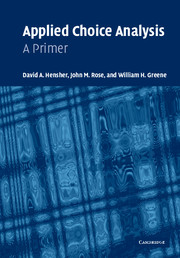Book contents
- Frontmatter
- Contents
- List of figures
- List of tables
- Preface
- Part I Basic topics
- 1 In the beginning
- 2 Basic notions of statistics
- 3 Choosing
- 4 Paradigms of choice data
- 5 Processes in setting up stated choice experiments
- 6 Choices in data collection
- 7 NLOGIT for applied choice analysis: a primer
- 8 Handling choice data
- 9 Case study: mode-choice data
- 10 Getting started modeling: the basic MNL model
- 11 Getting more from your model
- 12 Practical issues in the application of choice models
- Part II Advanced topics
- Glossary
- References
- Index
4 - Paradigms of choice data
Published online by Cambridge University Press: 05 September 2012
- Frontmatter
- Contents
- List of figures
- List of tables
- Preface
- Part I Basic topics
- 1 In the beginning
- 2 Basic notions of statistics
- 3 Choosing
- 4 Paradigms of choice data
- 5 Processes in setting up stated choice experiments
- 6 Choices in data collection
- 7 NLOGIT for applied choice analysis: a primer
- 8 Handling choice data
- 9 Case study: mode-choice data
- 10 Getting started modeling: the basic MNL model
- 11 Getting more from your model
- 12 Practical issues in the application of choice models
- Part II Advanced topics
- Glossary
- References
- Index
Summary
Statistics: The only science that enables different experts using the same figures to draw different conclusions.
(Evan Esar, 1899–1995)Introduction
We noted in chapter 3 the existence of two sources of influences on choice behavior. We termed these influences attributes if they relate to the description of an alternative, and characteristics if they are related to an individual's prejudices (or tastes) represented by socio-economic variables and context influences such as the data collection strategy. These sources of influence are all essential to both the development and estimation of the basic choice model as they represent the constituent ingredients of the representative component of the utility function. It is these influences that we hope to attach weights to through some estimation process so as to develop an understanding of their relative importance on the decision-making process.
In order to estimate a model and derive the relative weights for the attributes, sociodemographic characteristics (SDC), and contextual influences, we require data. We write this chapter with the aim of introducing the issues surrounding choice data. Given the differences between attributes and SDC characteristics, you will see below that different data are required for each.
In chapter 1 we briefly introduced the concepts of stated preference (SP) and revealed preference (RP) data, the former often referred to as “stated choice data.” In the choice literature, these two data paradigms are associated with the attributes of the alternatives. The collection of SDC data and data on contextual influences is not associated with any particular data paradigm within the literature, being collected via traditional survey means.
- Type
- Chapter
- Information
- Applied Choice AnalysisA Primer, pp. 88 - 99Publisher: Cambridge University PressPrint publication year: 2005
- 1
- Cited by



